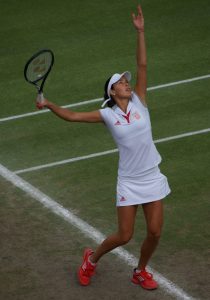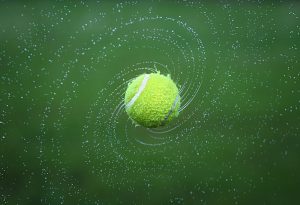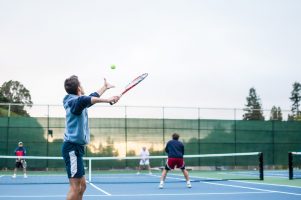The Basic Shots In Tennis
There are a great many shots in tennis, from groundstrokes to volleys, serves and overheads. Each shot, or stroke, has it’s own elements and varieties, and takes time to master them. Forehands, backhands, drop shots and lobs are all a part of every match. As you learn them and practice with them your game will improve and your competitive level will increase. Approach shots, passing shots, and even a chip and charge can all be a part of your game. Repetition is the ultimate teacher in tennis, and the great variety of shots out there means it’s possible to continue improving your tennis game for a very long time to come.

The Serve
Since every point in a tennis match begins with a serve we will do the same. The game begins when the server stands behind the baseline and to the right of the center line (duece court) The server must hit the tennis ball into the opposite service box (the opponents duece court) without first letting the ball bounce on the court before contact. The ball must not touch the net but must fall inside the service box. Hitting the lines of the box (or any boundary in tennis) is in play and the point continues as if it was hit inside the box. Anywhere outside of the boundary lines of the box is considered “out”.
A player will have two chances to convert their serve. If they fail in their two chances, then the opponent is awarded the point and the next point will begin. For this point, the server will stand to the left of the center line (the ad court), serving to the opponents ad court. If the ball hits the net and still bounces in the opponents box, that is called a “let” and the player is allowed to try the serve again as a do over. The server is allowed one “let” per point.
The Service Motion
After the ball is tossed (a right handed player will toss with their left hand, and a left handed player will toss with their right hand), the server swings the racket over his head in a forward motion to strike the ball at the highest point of it’s toss. This will almost feel like throwing a baseball overhand from the outfield to home plate. The server will continue the service motion even after striking the ball. This is called the follow through, and it’s consistency is vital to the consistency and success of your shots, serve and otherwise.
Once the ball is in play, the point continues until someone hits the ball out or in the net. This is when the creativity of tennis shows the most, as all of the shots can come up at any time from this point forward.

The Groundstroke Tennis Shots
Groundstrokes are tennis shots hit after the ball hits the ground. Most groundstrokes will have 3 parts to it that include a backswing, a point of contact, and follow through. Like every shot but the serve, they can be divided by forehands and backhands. Forehands are simply shot hit on the dominant side of your body using your dominant hand. If you are a right handed player (holding the racket with your right hand), you would hit the ball on the right side of your body. Backhands are shots hit on the non-dominant side of your body. For a right handed player this would be their left side. For the backhand you will still use your dominant hand, but most players also use their non-dominant to help gain more control and power.

Spin
All shots in tennis can be hit with a variety of spin or flatness. The 2 typical types of spin is topspin and slice. The other notable option is hitting a flat ball.
Topspin
Topspin happens when the ball is struck by going over the top of the ball, in almost a brushing motion, creating a forward spin. The ball in flight will have a natural tendency to fall in the court at a higher grade than a slice or flat shot. When it hits the court the forward spin will create a higher bounce and generally a faster trajectory than the other shots. Topspin on a forehand is usually achieved by using a western forehand grip, or semi western. Topspin on a backhand is achieved by using an eastern grip or even continental, using the same brushing motion.
Slice
A slice happens when the ball is struck by going under the ball, creating a backwards spin. The ball in flight will float down, and as it hits the court it will slow severely and have a low bounce. A forehand slice uses a continental grip. An eastern or semi western grip can be used for slice on a backhand.
Flat
A flat shot has little to no spin. The ball will bounce on a more traditional trajectory and will result in a middle of the road bounce and speed. The eastern grip is used for both the forehand and backhand to make a flat shot. A player will hit through the ball with little to no upward motion. This is the type of shot that tends to sail out the most, so be wary. It is also the type of shot most hit by beginners, so get comfortable with it. Your other shots and spins will develop from here.
The Different Groundstrokes
Groundstrokes include approach shots, lobs, passing shots, and chip and charge shots. Let’s break them down.
Approach Shots
An approach shot happens when the opponent hits a ball to your side of the court that is short enough that you can hit it and have enough time to run up to the net (at a minimum inside the service lines) for the next shot. Your approach shots should be hit inside the baseline. Use the momentum of your shot to move forward toward the net. Placing your approach shot carefully will put you in the controlling position of the point.
Too much power from this point may result in the ball falling out of bounds past the baseline. Using a shorter follow through will help here. Use this shot to dictate your opponents next shot, hopefully resulting in a well positioned volley for a put away.
Lob Shot
Lobs are high looping tennis shots meant to go over an opponents head that is at the net or to push an opponent back that you don’t want standing so close to the baseline. These upward shots are to be used sparingly and with topspin, in order to increase the odds of them falling in the court and not out of bounds. The difference will be opening up your racket face more toward the sky while decreasing the power of your shot so you don’t hit it over the fence. A couple of lobs per set can be expected, but if poorly executed this can result in a quick overhead winner from your opponent.
Passing Shots
A passing shot is one of the tennis shots you hit by your opponent while your opponent is at the net. Use mostly a topspin shot to maximize the use of your space and minimize your margin for error. Wait for the right opportunity for these shots, as a poorly timed (or placed) passing shot will just be a fantastic opportunity for an easy volley for your opponent. Cross court passing shots are very difficult because there is usually only a very small, precise space to hit the ball past them cross court, unless their momentum carries them severely out of position. The opportunities for a passing shot usually open up down the line, when the opponent only has to be slightly out of position for this to be effective.
Not every passing shot has to end in the ball blowing by the opponent inches out of their reach as they lunge for it. When they are out of position your passing shot that they return to you will generally be hit back without much effectiveness allowing an opportunity to control the point. It still might be one or two more shots until you win the point, but that passing shot that the opponent stabbed back fell short and in the middle of the court for a opportunistic approach shot that you can hit to an open court. That is an easier way to get to a win than trying to drive it within a 10 space left to right in between your opponent and the doubles alley (out of bounds in singles).
Drop Shot
The drop shot, usually a slice, is a shot hit very short or just over the net. Its purpose is to either catch an opponent sleeping on the baseline or out of position, to bring them up to the net as their net play may be subpar, or you are using this to move them back and forth, a good strategy against a good baseline style tennis player or counterpuncher. Using a flat shot can also be effective, especially on grass, where a flat shot will have a tendency to skid or slide. If you get handy with the racket, a bit of side spin here can throw an approaching opponent way off.
Chip Shot
The chip shot, used in the chip and charge method, is a great defensive shot on the return of serve. Against a powerful server with perhaps a lackluster mid-range game it is a surprise shot. The shot is hit with a slice, which gives the ball a bit of hangtime. This will give you a chance to get to the net while the server sets up for their shot. It is a dangerous shot that could give the server a great opportunity to hit a winner, so use it sparingly and ideally only to interrupt a flow of success that the opponent is carrying in the match.
Punch Return
The punch shot is a flat shot used in similar situations as the chip and charge, but gives you the opportunity to move back to the baseline. This shot could also be turned against you quickly, so use it sparingly and primarily as a defense mechanism.

Volley Shots in Tennis
The volley is a common tennis shot made at the net before the ball bounces on the ground. It is usually, but not always, made between the service line and the net. There are three types of volleys: the standard volley, the half volley, and the swinging volley.
The Standard Volley
The standard volley is really just called the volley. It’s the other two types that need a name to differentiate themselves. The volley is made with a very tight grip and a stiff wrist, usually using the continental grip. This grip allows the racket head to be in optimum position to ‘punch’ the ball back over the net. Volleys should be hit with one hand for either forehand or backhand, but lesser skilled players might use two hands for a backhand volley. While it may also be an effective strategy against powerful players, it will limit your reach on that side significantly.
When preparing to hit a volley at the net, face the opponent with your shoulders parallel to the net. Bounce slightly on the balls of your feet, waiting to decide your direction. When hitting, you should step forward with the foot opposite of the side you are hitting your shot. A right handed player hitting on the forehand (right) side will step forward with their left foot. Their non-dominant hand should be open faced with fingers spread (jazz hands). Keep it not too far from the racket (but not in a way to impede) ready to grab the racket throat and prepare for whatever comes next.
The Half Volley
The half volley is more like a half groundstroke using the volley principals. The ball bounces a just before you make contact, which means you’ll be catching the ball on the rise. A punching style of a volley works here. A full groundstroke would most likely result in the ball sailing past the baseline. These shots are difficult to control and can easily result in a loss of the point. They happen most often in no man’s land, which is why you should stay out of no man’s land, which is why they call it no man’s land.
The Swinging Volley
A Serena Williams favorite and one of my favorite tennis shots, too. This happens when you can get up to the net quick and as you’re moving forward the opponent hits a semi soft, generally flat shot, usually to your forehand. This scenario traditionally this would just be a volley. If you are accurate and comfortable this can be a real weapon and quickly end a point. Be careful, as the point will probably end in either a winner or an unforced error. Going over the top of the ball is the way to go. A slice would be difficult to control and a flat shot will probably land out.
Overhead Tennis Shots
The overhead tennis shot is very similar to a serve, using the same principals and motions. The overhead is the best shot against a lob. It is often thought that the overhead shot should be an easy winner, but that is not always the best application for it.
An overhead made near the net can become easy winners if you carefully use the large open court. The further back your overhead is hit, the less power and more placement you should put on the ball. Use light topspin or a flat shot. You will be hitting the ball while it is on its downward trajectory. Limit the topspin if used, as too much will see your ball fall to the bottom of the net. Use a softer serving motion with a bit less spin to make an accurate and less powerful overhead shot.
When you are heading into position, track the ball by literally pointing to the ball with your non-dominant hand. This will help train your eye to track the ball as it falls. Try to be standing with your shoulders roughly perpendicular to the net when you get in position. Don’t forget the follow through. The ferociousness of the follow through should be tamed or you will see your ball hit the back of the fence before it hits the ground.
What Strokes Do I Learn First
Begin with the forehand tennis shot. It is the easiest and most comfortable to learn. The backhand will follow. From there, I recommend the serve, and then the volley. Keeping to the most basic of basics at the beginning is important. There is no need to fully understand the half volley before knowing how to hit a backhand. Incorporate footwork, positioning, and strategy alongside your shots.
Enjoy ALL of the shots in tennis you learn along the way, because this game is just so much fun! Enjoy your tennis!!!

